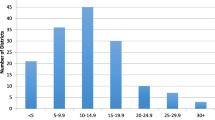Abstract
Trichiasis/Entropion are the severe consequences of chronic trachoma during early life. Blindness and vision loss is preventable with timely lid surgery to correct trichiasis. In a trachoma hyperendemic region of Central Tanzania, a two year follow-up survey was conducted among 205 women with trichiasis to determine the proportion who had had surgery and the barriers to having surgery. Only 18% of the women had undergone surgery by the 2 year follow-up. Those who had surgery tended to report more eye problems at baseline and have more corneal opacities at baseline. Barriers preventing women from going to surgery were costs, problem of children left at home alone, and difficulties in identifying someone to accompany them to the health center. Over 2/3 of those who had surgery reported a significant decrease in pain, improvement of vision, and improved ability to carry out activities of daily life. Ways to improve compliance with recommendations for trichiasis surgery need to be developed.
Similar content being viewed by others
References
Thylefors B. Primary eye care and the design of the WHO Programme for the Prevention of Blindness. Intl Ophth Clinics 30-1, Winter 1990.
West S, Munoz B, Turner V, Mmbaga BBO, Taylor HR. The epidemiology of trachoma in Central Tanzania. Int J Epidemiol 1991;20: 1088–92.
Reacher MH, Munoz B, Alghassany A, Daar AS, Elbualy M, Taylor HR. A controlled trial of surgery for trachomatous trichiasis of the upper lid. Arch Ophthalmol 1992; 100: 667–74.
Reacher M, Foster A, Huber J.Trichiasis Surgery far Trachoma The Bilamellar Tarsal Rotation Procedure. WHO/PBL/93.29.
Rapoza PA, West S, Ktala SJ, Taylor HR. Prevalence and causes of vision loss in central Tanzania. Int Ophthalmol 1991; 15: 123–9.
Turner VM, West S, Munoz B, Katala SJ, Taylor HR, Halsey N, Mmbaga BBO. Risk factors for trichiasis in women in Kongwa, Tanzania: a case control study. Int J Epidemiol 1993; 22: 341–7.
Thylefors B, Dawson CR, Jones BR, West S, Taylor HR. A simple system for the assessment of trachoma and its complications. Bull WHO 1987; 65: 485–8.
Brilliant G, Lepkowski J, Zurita B, Thulasiraj RD and MBA. Social determinants of cataract surgery utilization in South India. Arch Ophthalmol 109(4): 584–9, 1991.
Kara Newton J, Contrera F, Campos M, Delgado A, Mowery R, Ellwein L. Screening and surgical intervention results from cataract-free zone projects in Campinas, Brazil and Chimbote, Peru. Int Ophthalmol 14:155–64, 1990.
Vicencio C, Verdaguer JI, Verdaguer JT, Vargas G et al. Proyecto San Vicente de Tagua Tagua: Zona Libre de catarata. Archives Chilenos de Oftalmologia 48(1): 56–64, 1991.
Concha M. The natural history of senile cataract in the Chilean Health System. Ph.D. Thesis. Johns Hopkins School of Hygiene and Public Health, May, 1993.
Author information
Authors and Affiliations
Rights and permissions
About this article
Cite this article
West, S., Lynch, M., Munoz, B. et al. Predicting surgical compliance in a cohort of women with trichiasis. Int Ophthalmol 18, 105–109 (1994). https://doi.org/10.1007/BF00919249
Accepted:
Issue Date:
DOI: https://doi.org/10.1007/BF00919249




